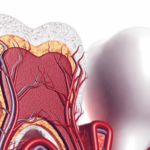Dental fillings play a crucial role in maintaining oral health by restoring teeth damaged by decay or injury. Understanding the various materials, types, and potential issues associated with dental fillings is essential for informed decision-making and optimal oral care. In this comprehensive guide, we’ll delve into the diverse world of dental fillings, exploring materials, types, and addressing concerns such as sensitivity and allergies.
Materials Used in Dental Fillings:
- Amalgam: Amalgam fillings, often known as silver fillings, consist of a blend of metals, including silver, tin, copper, and mercury. They are durable and cost-effective but have become less popular due to their silver colour and mercury content.
- Composite Resin: Composite resin fillings are tooth-coloured and blend seamlessly with natural teeth. Made of a mixture of plastic and glass, they offer aesthetic appeal and are commonly used for front teeth and visible areas.
- Ceramic: Ceramic or porcelain fillings are aesthetically pleasing and durable. They are resistant to staining and provide a natural appearance, making them a popular choice for visible teeth.
- Gold: Gold fillings are durable and long-lasting. They are well-tolerated by gum tissues and provide a strong, reliable option. However, their distinctive gold colour may be a deterrent for individuals seeking a more discreet option.
Types of Dental Fillings:
- Direct Fillings: Direct fillings are applied directly to the tooth in a single visit. This category includes composite resin and amalgam fillings, among others.
- Indirect Fillings: Indirect fillings, such as inlays and on lays, are fabricated outside the mouth and then bonded to the tooth. They are often used when the damage is too extensive for a direct filling.
- Temporary Fillings: Temporary fillings are a short-term solution, often used in emergency situations. They provide temporary protection until a permanent filling can be placed.
Sensitivity and Allergy Issues:
- Tooth Sensitivity: It’s common to experience tooth sensitivity after a dental filling. This sensitivity usually resolves on its own, but if it persists, consulting with the dentist is advisable. Sensitivity may be heightened when consuming hot or cold foods and beverages.
- Allergic Reactions: Allergic reactions to dental filling materials are rare but possible. Allergies to metals like nickel or components in composite resin may occur. Symptoms include swelling, redness, or itching, and should be promptly addressed with the dentist.
- Dental Pulp Sensitivity: In some cases, dental fillings may cause temporary irritation to the dental pulp, leading to sensitivity. This typically subsides as the tooth adjusts to the filling.
Caring for Dental Fillings:
- Maintain Good Oral Hygiene: Regular brushing, flossing, and routine dental check-ups are essential to maintain the health of dental fillings and prevent decay in adjacent teeth.
- Avoid Excessive Force: While dental fillings are durable, avoiding excessive force such as biting down on hard objects can prolong their lifespan.
- Attend Regular Check-ups: Regular dental check-ups allow the dentist to monitor the condition of fillings and address any issues promptly.
Conclusion: Dental fillings are a cornerstone of preventive and restorative dentistry, preserving teeth and promoting overall oral health. The choice of filling material and type depends on individual factors, including aesthetic preferences, budget, and the extent of tooth damage. Sensitivity and allergy issues are relatively uncommon but should be communicated with the dentist to ensure appropriate materials are used. As with any dental procedure, maintaining good oral hygiene and attending regular check-ups are key to the longevity and success of dental fillings. A collaborative approach between patients and dentists ensures optimal oral health and a confident smile for years to come.




